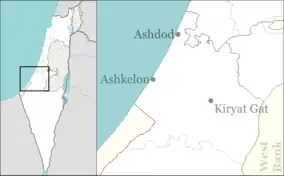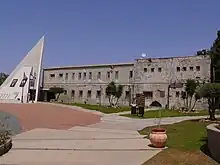Negba
Negba (Hebrew: נֶגְבָּה) is a kibbutz in southern Israel. Located in the northern Negev desert near the cities of Kiryat Malakhi and Ashkelon, it falls under the jurisdiction of Yoav Regional Council. In 2021 it had a population of 967.[1]
Negba
נגבה نجبا | |
|---|---|
%D7%9E%D7%95%D7%96%D7%99%D7%90%D7%95%D7%9F_%D7%AA%D7%97%D7%AA_%D7%9B%D7%99%D7%A4%D7%AA_%D7%94%D7%A9%D7%9E%D7%99%D7%9D_%D7%91%D7%A7%D7%99%D7%91%D7%95%D7%A5_%D7%A0%D7%92%D7%91%D7%94%252C.jpg.webp) | |
 Negba | |
| Coordinates: 31°39′39″N 34°40′59″E | |
| Country | Israel |
| District | Southern |
| Council | Yoav |
| Affiliation | Kibbutz Movement |
| Founded | 12 July 1939 |
| Founded by | Hashomer Hatzair members |
| Population (2021) | 967[1] |
| Website | www.negba.org.il |
The name of the kibbutz is based on a verse in the Book of Genesis (13:14), where God commands Abraham to cast his eyes and travel throughout the land of Israel, toward the north, south, east and west. The word "negba" means "southward" in Biblical Hebrew.
History
Foundation
Kibbutz Negba was founded on 12 July 1939 as part of the tower and stockade enterprise. The first settlers were members of Hashomer Hatzair from Poland. It was the southernmost Jewish settlement in Mandatory Palestine.
Battle for Negba, 1948
In the 1948 Arab–Israeli War, the Israeli military engaged in many battles with Egypt. When the Egyptians invaded on 15 May 1948, their forces advanced and captured the police station, Iraq-Suweidan, a Tegart fort named after the nearby Arab village, that controlled the route to the Negev. Aside from the police station, the Egyptians seized Arab villages near the kibbutz, from which they attacked Jewish vehicles travelling on the roads from Ashkelon to Hebron and Jerusalem.
The kibbutz was destroyed in the heavy fighting which went on for three months. On 9 November 1948, after the defeat of the Egyptian army in Operation Yoav, the police station was captured by the Israel Defense Forces.
A memorial to the fallen soldiers was constructed next to the military cemetery: a man and a woman from the kibbutz with a fighting soldier. Next to the memorial statue stands an Egyptian tank. The kibbutz water tower, pockmarked with bullet holes, is a testimony to the fierce battle.
Gallery
 Negba foundation 1939
Negba foundation 1939 Tower and stockade replica
Tower and stockade replica Negba 1942
Negba 1942 "Meztudat Yoav", the former Iraq Suweidan police station
"Meztudat Yoav", the former Iraq Suweidan police station Nathan Rapoport, memorial to the participants in the 1948 battles
Nathan Rapoport, memorial to the participants in the 1948 battles
Economy
The kibbutz economy is based on poultry, cattle, orchards, vegetables and two factories. It also has a history museum featuring a reconstructed model of the tower and stockade settlements. Negba, along with Sde Yoav, operate Hamei Yoav, a spa with hot springs and thermo-mineral baths.[2]
Under a new financial arrangement, members who left the kibbutz are able to return as "economically independent members." They live in residences registered in their own name and are partners with equal rights and obligations in the communal element of the kibbutz (education, culture, welfare and infrastructure) but not in the productive assets (agriculture, industrial enterprises and shares in the dairy cooperative Tnuva).[3]
Geography
Climate
| Climate data for Negba (Temperature: 1995–2010, Precipitation: 1980-2010) | |||||||||||||
|---|---|---|---|---|---|---|---|---|---|---|---|---|---|
| Month | Jan | Feb | Mar | Apr | May | Jun | Jul | Aug | Sep | Oct | Nov | Dec | Year |
| Record high °C (°F) | 33.0 (91.4) |
32.4 (90.3) |
37.7 (99.9) |
42.0 (107.6) |
46.5 (115.7) |
42.0 (107.6) |
38.4 (101.1) |
39.0 (102.2) |
42.4 (108.3) |
41.6 (106.9) |
36.0 (96.8) |
33.0 (91.4) |
46.5 (115.7) |
| Average high °C (°F) | 17.6 (63.7) |
18.2 (64.8) |
20.7 (69.3) |
24.6 (76.3) |
27.8 (82.0) |
30.0 (86.0) |
31.7 (89.1) |
31.9 (89.4) |
30.8 (87.4) |
28.1 (82.6) |
24.3 (75.7) |
19.9 (67.8) |
25.5 (77.8) |
| Daily mean °C (°F) | 12.9 (55.2) |
13.3 (55.9) |
15.3 (59.5) |
18.4 (65.1) |
21.5 (70.7) |
24.3 (75.7) |
26.5 (79.7) |
26.9 (80.4) |
25.7 (78.3) |
23.0 (73.4) |
18.9 (66.0) |
15.0 (59.0) |
20.1 (68.2) |
| Average low °C (°F) | 8.3 (46.9) |
8.3 (46.9) |
9.9 (49.8) |
12.3 (54.1) |
15.2 (59.4) |
18.6 (65.5) |
21.3 (70.3) |
22.0 (71.6) |
20.6 (69.1) |
17.9 (64.2) |
13.5 (56.3) |
12.1 (53.8) |
15.0 (59.0) |
| Record low °C (°F) | −2.5 (27.5) |
−1.5 (29.3) |
0 (32) |
2.5 (36.5) |
6.0 (42.8) |
11.5 (52.7) |
15.0 (59.0) |
14.0 (57.2) |
12.8 (55.0) |
9.0 (48.2) |
1.0 (33.8) |
−2.6 (27.3) |
−2.6 (27.3) |
| Average rainfall mm (inches) | 119 (4.7) |
105 (4.1) |
55 (2.2) |
11 (0.4) |
3.2 (0.13) |
0 (0) |
0 (0) |
0 (0) |
2.3 (0.09) |
26 (1.0) |
66 (2.6) |
103 (4.1) |
490.5 (19.32) |
| Average rainy days (≥ 0.1 mm) | 11 | 10 | 7 | 2 | 0.7 | 0.1 | 0 | 0 | 0.2 | 3 | 6 | 9 | 49 |
| Source: Israel Meteorological Service[4][5] | |||||||||||||
Notable residents
- Yossi Peled (born 1941), Israeli general and politician
- Anat Maor (born 1945), Israeli politician
- Avshalom Vilan (born 1951), Israeli politician and economist
References
- "Regional Statistics". Israel Central Bureau of Statistics. Retrieved 22 February 2023.
- Hamei Yoav Archived 2009-11-22 at the Wayback Machine
- Less equality, more freedom and Kibbutz Negba's prodigal sons return Haaretz
- "Temperature average". Israel Meteorological Service. Retrieved 1 December 2011.(in Hebrew)
- "Precipitation average". Retrieved 12 July 2011.(in Hebrew)